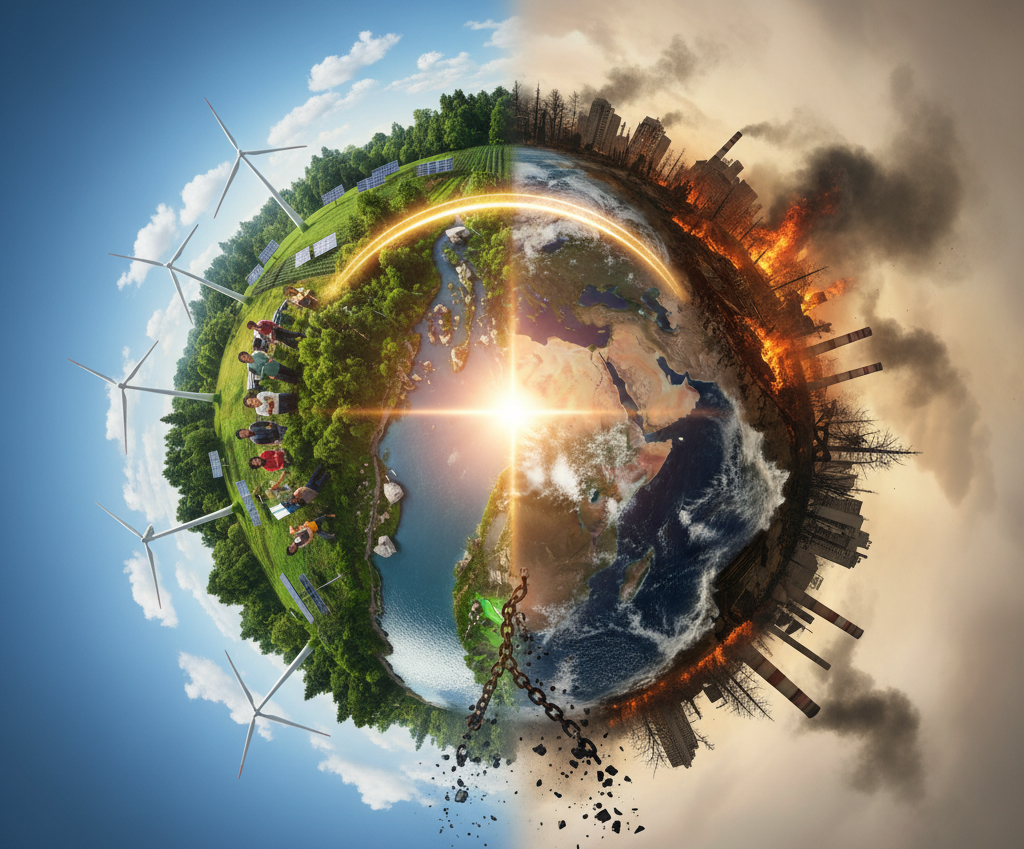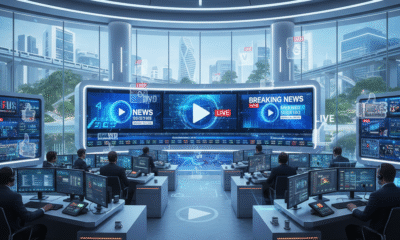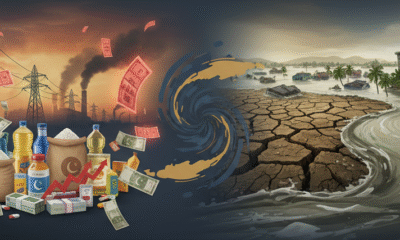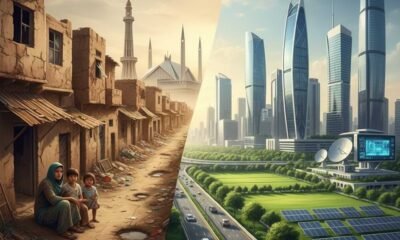Pakistan News
What Is the Biggest Problem Facing Our World Today?

Introduction: Many Crises, One Root Problem
Ask ten people what the world’s biggest problem is, and you’ll hear ten urgent answers: climate change, wars, economic inequality, pandemics, disinformation, food insecurity, water scarcity, youth unemployment, or the darker side of AI. All of these are real and pressing. But when you zoom out and look for the common root, a clearer picture emerges: the defining challenge of our time is our global coordination failure—our repeated inability to act together, at speed and scale, on problems that cross borders, generations, and sectors.
From Pakistan to Peru, from the Sahel to Silicon Valley, problems now move faster than our institutions, while solutions remain trapped behind political gridlock, mistrust, and misaligned incentives. This article explores why coordination failure sits at the center of today’s crises, how it shows up across climate, economy, technology, public health, and geopolitics, and crucially, what can be done—by governments, businesses, media, civil society, and citizens—to build a world capable of solving shared problems before they solve us.
As a platform committed to public-interest journalism and national development, Chal Pakistan News Channel believes that naming the root problem is the first step to solving it.
Section 1: Why “Coordination Failure” Is the Meta-Crisis
1. Problems Are Borderless; Governance Isn’t
Greenhouse gases don’t carry passports; neither do viruses, cyberattacks, or extremist propaganda. Yet decision-making remains mostly national, and often partisan. This mismatch—borderless risks, bordered responses—creates action gaps. Even when most people agree on the risk, they disagree on who should pay, who should move first, or how to share benefits.
2. The Speed Mismatch
Technology accelerates change; institutions move slowly. By the time regulators understand an emerging risk (deepfakes, algorithmic bias, biological threats), the problem has scaled. The result is a constant game of catch-up.
3. Incentives Reward Delay
Political cycles are short; climate and infrastructure payoffs are long. Markets reward quarterly gains; resilience is a long-term investment. Leaders who act boldly may bear costs now while benefits arrive later—often under someone else’s watch. The easiest choice becomes postponement, wrapped in reassuring rhetoric.
4. Trust Deficit
Trust is the lubricant of cooperation. In many countries—including Pakistan—trust in institutions has declined due to corruption scandals, poor service delivery, and polarized information ecosystems. Without trust, even well-designed policies struggle to achieve compliance.
Section 2: How the Meta-Crisis Drives Specific Crises
A. Climate Change and Environmental Degradation
We have the technology to cut emissions, build resilient cities, restore ecosystems, and transition to clean energy. What we lack is synchronized deployment, equitable financing, and stable policy signals. Pakistan’s devastating floods and heatwaves are reminders that climate vulnerability is not a future scenario—it’s a present reality. Without global coordination—on loss-and-damage funding, climate-resilient agriculture, and grids that can absorb renewables—countries get stuck between urgent adaptation and aspirational mitigation.
B. Economic Inequality and Social Fragmentation
Globalization and digitization created winners and losers. Where safety nets are thin, the losers fall far and fast, fueling resentment and polarization. A world that can coordinate on tax transparency, anti-corruption measures, and skills mobility is a world that can rebuild a middle class—especially critical for young, populous nations like Pakistan.
C. Information Disorder
Disinformation thrives where oversight is weak and incentives reward virality over veracity. International coordination is needed on platform standards, provenance tools (to prove what’s real), and cross-border accountability for state-backed manipulation. Local media literacy programs and independent, credible newsrooms are equally essential.
D. Public Health and Pandemic Preparedness
We learned in 2020 that no one is safe until everyone is safe. Shared surveillance, equitable vaccine manufacturing, and rapid-response financing remain incomplete. Without binding agreements and transparent data sharing, the next outbreak will again outpace our fragmented responses.
E. Technology Governance (AI, Cyber, and Bio)
AI can transform education, health, and productivity—but it can also concentrate power, automate bias, or supercharge misinformation. Cyberattacks ignore borders; synthetic biology lowers the barrier to designing pathogens. We need interoperable guardrails: shared audit standards, red-team testing, watermarking, liability frameworks, and crisis “kill-switch” cooperation among states and companies.
F. Geopolitical Rivalry
Great-power competition complicates everything. Supply chains for chips, batteries, and critical minerals are increasingly securitized, slowing the green transition and raising costs. Confidence-building measures—like crisis hotlines, data-sharing on near-miss incidents, and scientific collaboration—can reduce the risk of miscalculation.
Section 3: Pakistan’s Lens—Risks and Opportunities
Pakistan sits at the intersection of demographic momentum and climate exposure. The median age is young—a massive advantage if skills, entrepreneurship, and connectivity are prioritized. Yet water stress, energy volatility, debt constraints, and regional tensions raise the stakes.
Key national priorities in a coordination world:
- Climate Resilience First. Invest in flood defenses, heat-resistant urban planning, early-warning systems, and climate-smart agriculture (drought-tolerant seeds, efficient irrigation, precision weather data for farmers).
- Energy Transition with Security. Expand solar and wind where feasible, modernize the grid, reduce line losses, and unlock distributed generation for SMEs and households.
- Digital Public Infrastructure. Interoperable payment rails, digital identity, and e-governance reduce leakage and increase trust—vital for social protection and tax fairness.
- Skills and Export Competitiveness. Align vocational training with global services demand (IT, BPO, creative industries, climate services). Promote remote work pipelines and diaspora mentorship.
- Data Integrity and Public Interest Media. Support media literacy, fact-checking networks, and transparent data sharing across ministries and provinces to counter rumor economics and policy whiplash.
This is where a responsible national media agenda matters. By centering evidence, convening stakeholders, and maintaining editorial independence, Chal Pakistan News Channel can help convert fragmented debates into focused action.
Section 4: What Real Solutions Look Like—From Local to Global
1) A Climate “Execution Stack”
- Carbon Pricing + Dividend: Predictable carbon price signals investment; dividends protect vulnerable households.
- Loss & Damage Finance: Rapid-disbursement facilities for countries hit by climate disasters.
- Green Industrial Policy: De-risk local manufacturing of solar components, batteries, and efficient appliances, paired with export strategies.
- Nature Markets with Integrity: Pay farmers and communities for verified ecosystem services (mangrove restoration, watershed protection).
2) A Trust-Building Information Ecosystem
- Platform Accountability: Interoperable standards for content provenance, risk audits, and transparent algorithms.
- Public Service Media & Local News Support: Grants tied to editorial independence and community reach.
- Media Literacy in Schools: Critical thinking and source evaluation integrated into curricula.
- Open Government Data: Real-time dashboards on budgets, air quality, water, and health reduce rumor and enable civic innovation.
3) A Pandemic Readiness Compact
- Regional Surveillance Hubs: Cross-border genomic sequencing and signal sharing.
- Distributed Manufacturing: Licensing and incentives for regional vaccine and therapeutic production.
- Crisis Logistics Playbooks: Pre-negotiated freight and customs corridors; stockpiles of PPE and test kits.
- Community Health Workers: Digitally equipped cadres for last-mile communication and response.
4) Guardrails for Transformative Tech
- AI Risk Tiers: Higher-risk applications require stricter testing, documentation, and post-deployment monitoring.
- Watermarking & Provenance: Tools to identify synthetic media at scale, with penalties for deceptive misuse.
- Secure Compute & Cyber Hygiene: Minimum standards for critical infrastructure; mandatory incident reporting.
- Biosecurity by Design: Screening DNA orders, lab accreditation, and red-team exercises.
5) Economic Inclusion and Education
- Targeted Cash Transfers: Digitally delivered support tied to education and health milestones.
- Skills Accelerators: Public-private bootcamps aligned with employer demand; recognition of prior learning.
- SME Finance & Export Support: Credit guarantees, invoice factoring, and trade facilitation.
- Urban Productivity: Reliable transport, zoning reforms, and affordable broadband to unlock agglomeration benefits.
Section 5: The Media’s Responsibility—From Spectacle to Solutions
News can amplify fear or empower action. In a coordination failure world, the most valuable journalism:
- Explains trade-offs clearly (who pays, who benefits, over what timeline).
- Tracks execution, not just announcements (what changed on the ground?).
- Elevates local innovators and evidence-based policies.
- Builds coalitions by giving voice to farmers, youth, scientists, SMEs, and policymakers together.
- Combats disinformation by linking claims to verifiable data and offering context, not just rebuttals.
That’s the editorial promise we aim to champion at Chal Pakistan News Channel—to move the national conversation from “who to blame” to “how to build.”
Section 6: A Practical Playbook for Pakistan
- National Resilience Dashboard: Integrate hydrology, weather, crop, health, and energy data—open to provinces, media, and researchers.
- Pakistan Climate Corps: Youth service program deploying to mangrove restoration, canal desilting, urban cooling, and disaster preparedness.
- Made-in-Pakistan Green Kits: Duty-rebated packages for rooftop solar, efficient fans, LEDs, and insulation for SMEs and households.
- Skills-for-Exports Pact: Industry-designed curricula, English fluency, cloud certifications, and placement pipelines targeting high-demand global roles.
- Misinformation Response Unit: Rapid fact-checking partnership across newsrooms, universities, and the telecom sector—using open protocols and transparent corrections.
- Diaspora Catalysts: Structured investment and mentorship vehicles plugging Pakistani founders into global markets.
Section 7: The Mindset Shift We Need
Solving the coordination meta-crisis demands a new civic muscle:
- From outrage to outcomes. Ask: what policy or behavior changes tomorrow because of this story?
- From zero-sum to positive-sum. Design policies where multiple groups win over time, even if benefits are staggered.
- From short-termism to stewardship. Treat infrastructure, ecosystems, and trust as assets to be handed to the next generation in better shape.
- From secrecy to radical transparency. Publish data, document failures, and invite scrutiny. Trust grows when performance is visible.
Conclusion: The Case for Courageous Coordination
The world’s biggest problem is not lack of ideas or technology—it’s our inability to coordinate across borders, sectors, and timelines. Pakistan’s path to resilience and prosperity runs straight through this challenge: aligning government, markets, media, civil society, and citizens around shared goals, measurable outcomes, and honest timelines. The good news is that coordination can compound just as powerfully as neglect: each successful partnership makes the next one easier.
If we choose execution over excuses, evidence over ideology, and cooperation over cynicism, we can turn today’s meta-crisis into tomorrow’s competitive advantage—for Pakistan and for the world. That is the future we will continue to report on, scrutinize, and accelerate at Chal Pakistan News Channel.
FAQs (10)
- What do you mean by “global coordination failure”?
It’s the gap between the global scale of modern problems (climate, pandemics, cyber threats) and our fragmented, slow, or competitive responses. Different actors—countries, companies, platforms—don’t align incentives and timelines, so solutions stall. - Why not just say climate change is the biggest problem?
Climate change may be the most dangerous long-term threat, but even that is downstream of coordination—financing, technology transfer, fair burden-sharing, and policy stability. Fix coordination, and we dramatically accelerate climate solutions. - How does this affect Pakistan specifically?
Pakistan is highly climate-vulnerable and fiscally constrained. Coordination across provinces and with international partners is essential for disaster preparedness, water management, energy transition, and job creation in export-oriented sectors. - What role can media play in solving coordination failures?
Media can clarify trade-offs, track implementation, expose corruption, debunk falsehoods, and convene constructive debate. Solution-oriented journalism builds trust and reduces polarization. - Isn’t coordination just another word for bureaucracy?
No. Good coordination is about clear goals, data transparency, and time-bound accountability—not endless meetings. Bureaucracy is drift; coordination is decisive alignment. - How can ordinary citizens help?
Vote for evidence-based policies, support local initiatives, reduce personal emissions and waste, verify information before sharing, volunteer for resilience projects, and hold leaders accountable to measurable outcomes. - What about technology—doesn’t it solve coordination by itself?
Technology is an amplifier. Without shared rules and trust, it can worsen inequality and misinformation. With guardrails and inclusive design, it becomes a force multiplier for solutions. - How can Pakistan finance resilience and growth together?
Blend domestic reforms (tax fairness, energy losses reduction) with international climate finance, diaspora bonds, concessional loans tied to reforms, and private capital de-risked by guarantees. - What quick wins are realistic within 12–24 months?
A heat-health early warning system; targeted cash transfers via digital IDs; loss-reduction in power distribution; vocational programs aligned with export service jobs; and city-level pilots for flood resilience. - What success metric proves coordination is improving?
Fewer disaster fatalities, faster infrastructure delivery, lower line losses, higher school-to-job placement, reduced air pollution, and transparent dashboards where citizens can track progress in real time.












